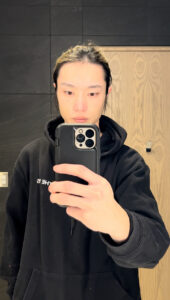Commentary on causes, common triggers, safe options, remedies, and treatments
Eczema on the scalp after shampooing is a common problem for some people. This can be caused by an individual’s scalp characteristics and interactions with the ingredients used in the shampoo. In this article, we will take a professional look at post-shampoo scalp eczema, why it occurs, what ingredients are likely to cause it, what are the safe options, and what to do and how to treat it.
Causes of scalp eczema
Allergic Reactions
This can be caused by allergic reactions to the ingredients in the shampoo. Scalp eczema can occur if you have sensitivities or allergies to certain ingredients.
Skin Sensitivity: The skin on the scalp is particularly sensitive and can be caused by hypersensitivity to external stimuli. People with sensitive skin tend to react more easily to common shampoo ingredients.
Sebum imbalance
Shampooing can cause sebum imbalance in the scalp. Excessive sebum removal or dryness of the scalp can lead to eczema on the scalp.
Ingredients that can cause
Surfactants
Surfactants in shampoos have a cleansing effect, but can be irritating to some people. In particular, sulfate-based and sulfate-based surfactants are highly irritating and may cause scalp eczema.
Fragrances and Colorants: Fragrance and colorants used in shampoos may cause irritation or allergic reactions in some people. Be especially careful with synthetic fragrances and artificial colors.
Preservatives
Some shampoos contain ingredients that are used as preservatives. Some people may have hypersensitivity reactions to preservatives, which can lead to scalp eczema.
Safe Choices and Caveats
Hypoallergenic Shampoo
To choose a shampoo that is less likely to cause scalp eczema, it is important to choose a product that is hypoallergenic. Check the ingredient list and choose one that does not contain surfactants, fragrances, or colorings, or that is mild.
Patch Test
We recommend doing a patch test before using any new shampoo. Apply the shampoo to a small area on the inner arm and wait at least 24 hours to see the reaction. It is safe to use on the scalp only if no unusual reactions are observed.
Coping and treatment
Review shampoo frequency and method
If you have scalp eczema, it is important to review shampoo frequency and method. Wash gently without irritating the scalp and avoid over-cleansing or rubbing.
Moisturizing Care
Use moisturizing care to prevent your scalp from drying out. It is important to keep your scalp properly moisturized by using a moisturizing scalp lotion or cream.
Professional Consultation
If scalp eczema becomes chronic or does not improve with self-treatment, it is recommended to consult a dermatologist or specialist. A specialist can make a proper diagnosis and suggest necessary treatments and prescription drugs.
Conclusion
Post-shampoo scalp eczema can be caused by an individual’s scalp characteristics and interactions with shampoo ingredients. You can prevent or manage scalp eczema by choosing safe shampoos and practicing good care. However, if you have chronic eczema or severe symptoms, it’s important to seek professional guidance. Achieve a comfortable shampoo experience while keeping your scalp healthy.
シャンプー後の頭皮湿疹:原因、引き起こしやすい成分、安全な選択肢、対処法、治療法についての専門的な解説
シャンプー後に頭皮が湿疹になる症状は、いくつかの人にとって一般的な問題です。これは個人の頭皮の特性やシャンプーに使用される成分との相互作用によって引き起こされる可能性があります。本記事では、シャンプー後の頭皮湿疹について、なぜそのような症状が起こるのか、引き起こしやすい成分は何か、安全な選択肢は何か、対処法や治療法について専門的に解説します。
頭皮湿疹の原因
- アレルギー反応: シャンプーに含まれる成分に対してアレルギー反応が起こることが原因となる場合があります。特定の成分に対する過敏症やアレルギーがある場合、頭皮湿疹が発生する可能性があります。
- 皮膚の過敏性: 頭皮の皮膚が特に敏感であり、外部刺激に対して過敏に反応することが原因となることがあります。過敏性皮膚の人は、一般的なシャンプーの成分に対しても反応しやすい傾向があります。
- 皮脂のバランスの乱れ: シャンプーの使用によって頭皮の皮脂バランスが乱れることが原因となることがあります。過度な皮脂の除去や頭皮の乾燥が起こると、頭皮が湿疹を引き起こす可能性があります。
引き起こしやすい成分
- 界面活性剤: シャンプーに含まれる界面活性剤は洗浄効果を持っていますが、一部の人にとって刺激的な成分となることがあります。特に硫酸系や硫酸塩系の界面活性剤は刺激性が強く、頭皮湿疹を引き起こす可能性があります。
- 香料や着色料: シャンプーに使用される香料や着色料は、一部の人にとって刺激性やアレルギー反応を引き起こすことがあります。特に合成香料や人工的な着色料は注意が必要です。
- 防腐剤: シャンプーの中には防腐剤として使用される成分が含まれています。一部の人は防腐剤に対して過敏な反応を示すことがあり、頭皮湿疹を引き起こす可能性があります。
安全な選択肢と注意点
- 低刺激性のシャンプー: 頭皮湿疹を起こしにくいシャンプーを選ぶためには、低刺激性の製品を選択することが重要です。成分表を確認し、界面活性剤や香料、着色料が含まれていないか、または刺激が少ないものを選ぶようにしましょう。
- パッチテスト: 新しいシャンプーを使用する前に、パッチテストを行うことをおすすめします。内側の腕の小さな部分にシャンプーを塗布し、24時間以上経過した後に反応を確認します。異常な反応が見られない場合にのみ、頭皮に使用することが安全です。
対処法と治療法
- シャンプーの頻度と方法の見直し: 頭皮湿疹が起きている場合、シャンプーの頻度や使用方法を見直すことが重要です。頭皮を刺激せずに優しく洗い、過度な洗浄や摩擦を避けるようにしましょう。
- 保湿ケア: 頭皮の乾燥を防ぐために、保湿ケアを行いましょう。保湿効果のある頭皮用のローションやクリームを使用し、頭皮を適切に保湿することが大切です。
- 専門家の相談: 頭皮湿疹が慢性化したり、自己処理では改善しない場合は、皮膚科医や専門家に相談することをおすすめします。専門家は適切な診断を行い、必要な治療法や処方薬を提案することができます。
結論
シャンプー後の頭皮湿疹は、個人の頭皮の特性やシャンプーの成分との相互作用によって引き起こされる可能性があります。安全なシャンプーの選択と適切なケア方法を実践することで、頭皮湿疹を予防したり対処したりすることができます。ただし、慢性的な湿疹や重度の症状がある場合は、専門家の指導を受けることが重要です。頭皮の健康を保ちながら、快適なシャンプー体験を実現しましょう。

